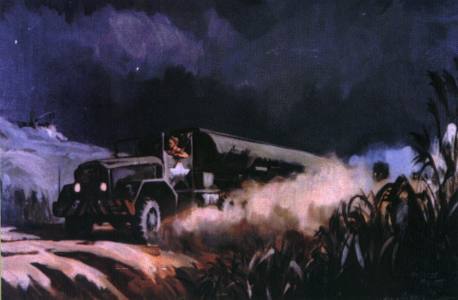|
Portraits of Patriotism "Moving Supplies"
One of my friends found this at work and framed it for me,
Written By CPT. Patrick Swan
Because they operated in the rear of the battlefield, convoy operators prior to Vietnam generally enjoyed relative safety from direct enemy attack, sabotage or ambush. The unconventional nature of warfare in Vietnam, however, eliminated the division between enemy and friendly forces ---
no front line and no rear boundaries.
This 1967 William Linzee Prescott oil painting depicts the harrows of convoying materials in Vietnam from Cu Chi to Tay Ninh when that elusive, well-concealed enemy lurked nearby. Straddling the primary land-and-river routes into the South Vietnamese capital of Siagon were hidden positions from which the enemy attacked passing convoys. Rooting them out took such effort that Cu Chi district was described as the "most bombed, shelled, gassed, defoliated and generally devastated area in the history of warfare."
Some soldiers who traveled this route described feeling as though they were ducks at a carnival shooting range. They expected to be ambushed at any moment as they moved ammunition, fuel and supplies back and forth to waiting U.S. units. Two soldiers most notably took that fight back to the enemy. SGT William Seay broke up an ambush at the cost of his life in 1968. SGT Larry Dahl dived onto a hand grenade to protect fellow soldiers while defending a convoy in 1970. Both soldiers earned posthumous Medals of Honor. The selfless sacrifice of these ment and the daily courage of thousands of other logisticians and transporters ensured that at no time was logistics support a constraint on major tactical operations. As the former top logistician in Vietnam, LTG Joseph M. Heiser Jr., recalled in 1972, "because both combat soldier and logistician were exposed to the same dangers, they maintained a close and wonderful relationship.
The 45th Surgical Hospital Tay Ninh Vietnam
My first tour of duty |






